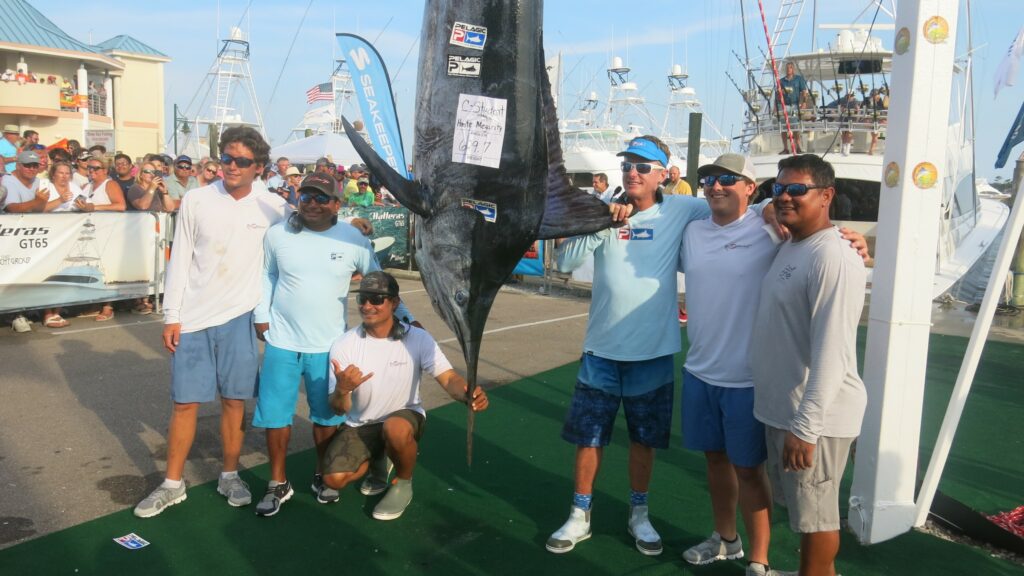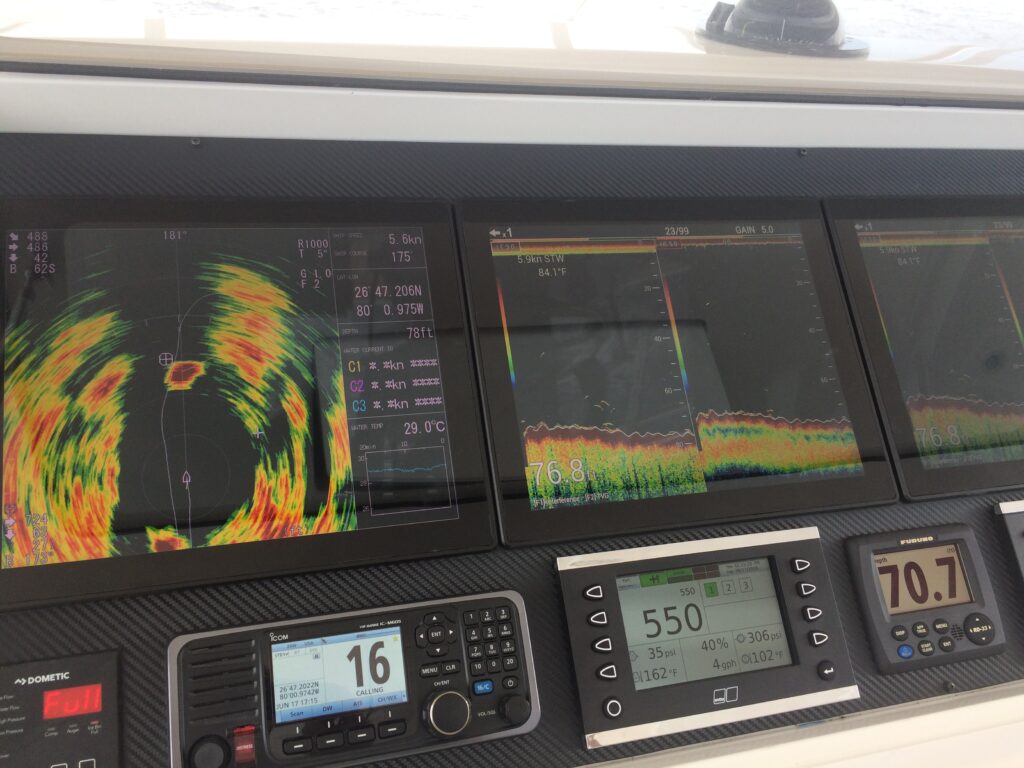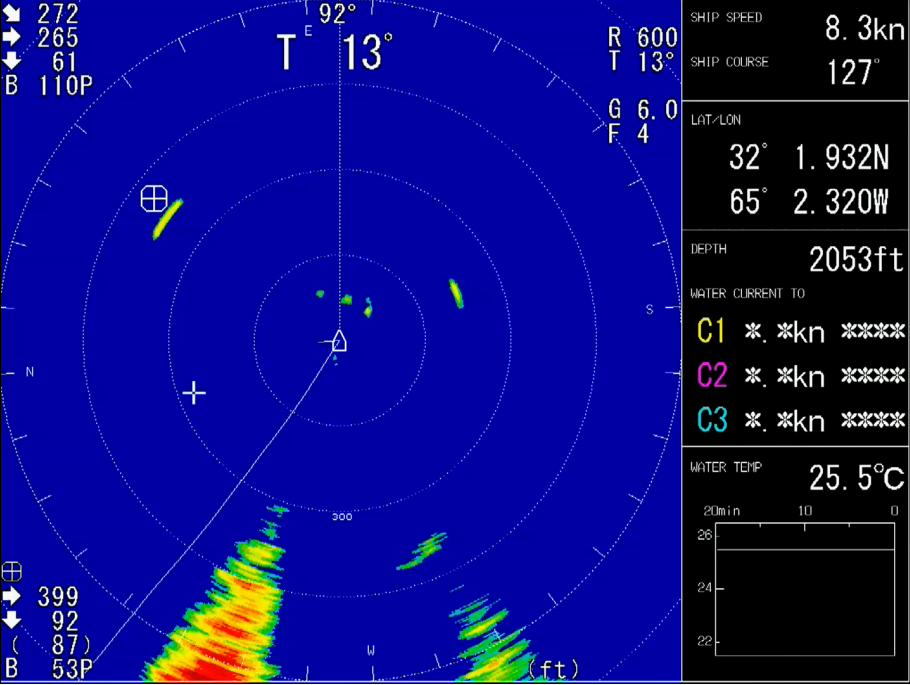Introduction to Omni Sonar: A Game-Changing Technology
Table of Contents
Capt. Ken Blackman’s eyes were glued to the screen of his Omni 360 sonar on the 66 Viking, C-Student. It was the final day of fishing in the 2021 Mississippi Gulf Coast Billfish Classic, and of over 100 boats and 460 anglers, the team sat skunked on the scoreboard. “We were live baiting, and because the sharks were ferocious, we couldn’t tow baits,” Blackman said. “So we decided to drive around and look for fish. Soon after, we marked a fish off a drill ship. My boys got ready, got in front of it and dropped a blackfin tuna over the side. It bites. Comes tight. Then pulls the bait out.” Blackman has used the Omni Sonar Fishing Technology for four years as the team fishes recreationally and in tournaments in the Gulf, U.S. East Coast, Caribbean and Pacific.
“I think, ‘let’s see if I can find it again,’ ” Blackman adds. “I start wheeling around looking for the fish, making big circles, and driving in all different directions, I find the fish again. Then, what looked like one actually turned into two. As we were approaching those two fish, I could see on the sonar that they were small blue marlin, probably two males. Then, another big mark popped up on my side. I said, ‘Hey boys, screw those two fish and reel up those baits really fast. Let’s go get this one.’ As soon as we pulled up to it, we fired the bait down and the fish ate. It was 629.7 pounds. Sonar isn’t new, but the Omni’s been a game changer for us.” The big blue, reeled in by angler Fletcher Megarity, was the second largest of the tournament. C-Student earned an A-plus by pocketing nearly $250,000 in prize money.

Understanding Omni Sonar: Beyond Traditional Sonar Systems
The big hype over Omni, or omnidirectional sonar, is that it doesn’t just let you look down, or take side glances, but also gives you a 360-degree panoramic view underwater. Plus, on average and with the best resolution, it does so out 1,000 to 1,500 feet.
“Omni sonar was originally designed for commercial fishing boats,” says Jon Closson, the fisheries and specialty products rep for Furuno USA, headquartered in Camas, Washington. “Over the years, we’ve started putting these on recreational fishing boats. Our most popular today for sportfishers is the CSH8LMK2, or the 8L, for short. On a 1,000-foot range, the mid-frequency 85 kHz Sonar updates the display in 360 degrees every 0.5 seconds. There’s good functionality too. Operators can tilt it and train the beam’s center on specific fish.”
The Competitive Edge: Omni Sonar in Action
Companies like Atlantic Marine Electronics (AME) offer customers omni sonars from Furuno as well as MAQ and Simrad Fisheries, and they are all great options, says Todd Talley, general manager of the New Gretna, New Jersey-headquartered AME. “The Furuno CSH-8L operating at 85 kHz is the most widely adopted to date and has a very broad base of experienced users which offers a lot of comfort to people who may not have experience with Omnis,” Talley said. “Multi-station installations can be a bit of a challenge for full control in multiple locations such as the bridge, salon, tower and cockpit. The MAQ and Simrad Fisheries SY50 are similar to each other in some regards, such as they both operate around the 60kHz frequency, have built-in stabilization, are PC-based, making features and updates possible, and use USB controllers so multi-station control is easy to accomplish and the ability to do dual range is a fantastic feature. The SY50 is the most compact hardware installation of the options, however, along with the highest price. The MAQ representing the best value in the market does require additional space for the hardware to be installed.” Including installation, the price of an Omni sonar can range from $110,000 to $120,000. Huge demand for these electronics, especially by tournament fishermen, and a finite production is keeping prices steady.

Expert Insights: Captains Share Their Omni Sonar Experiences
“I don’t think there’s a new boat being built today that doesn’t have Omni sonar,” says Capt. Rich Barrett, of the 73 Bayliss, Shark Byte. “It’s pretty much an obvious investment and a drop in the bucket on typical five- to seven-million-dollar sportfishing boats.” Shark Byte travels to the Bahamas in the spring, and the Carolinas to Nantucket in the summer and fall. Barrett attributes 80 percent of Shark Byte’s catches to tracking fish by sonar.
“It’s like Seakeepers weren’t a common thing a decade or so ago, and now everyone is putting them in,” Barrett adds. “An important point is that the Omni works better with a more stable platform, which the Seakeeper provides. If you’re fishing at a 10- or 12-degree tilt on your Omni and your boats rolling 10 to 12 degrees, you’re going to get a lot of flash from up underneath the waves, and not the results you’re looking for.”
In addition to Capts. Blackman and Barrett, Capt. Steve Lassley with Bad Company, Capt. Jon Meade on the 62 Spencer, Showtime!, and Capt. Brandon Walton on the 64 Viking, War Party, shared their first-hand experiences in using the Omni, as well as their tips and tricks. Each of them has used Furuno’s 8L.
Mastering the Technology: Learning Curve and Top Tips
Understanding the Basics: The Instruction Manual

The Omni, like most electronics, comes with an instruction manual. “I’ve read the manual three times, and I still use it as a refresher,” says Barrett. “When you first read it, it seems like it’s all Chinese. You’re like, ‘I have no clue what they’re talking about.’ It can be overwhelming. There’s a lot to it. But then as you become more familiar with the equipment and you reread the manual, it starts to make sense.
Gaining Practical Experience: Time in the Chair
There’s a need for just spending time in the chair using it. For example, different things, from mammals to fish, have different signatures on the screen. You don’t learn that until you see enough of it. So it’s time in the chair to learn to differentiate what you’re looking at.”
Reading the screen is the easy part, says Bad Company’s Lassley, who started using non-Omni style sonars to fish for blue marlin back in 1988, and has been using the Omni for the last five years on Bad Company’s fleet of global sportfishers. Lassley is hands down one of the most experienced sportfishing captains when it comes to sonar operation, having won over $7 million in prize money. Today, he finds about 70 percent of what they catch with this equipment.
Overcoming Old Habits: The Importance of Screen Time
“The hard part is to get people to quit looking behind the boat at their spread and to look at the screen,” Lassley says. “Most of the guys are looking over their shoulders because that’s what they were taught years ago. What I tell everybody is that there’s nothing behind the boat that a good captain needs to know about. After all, the sonar is going to tell you that way before it ever comes into the spread. Plus, if you break concentration for even three or four seconds, especially when you’re in adverse conditions and an image might only be on the screen for three or four pulses, you will never even see it. If you get really good with sonar, you should never look behind the boat until a fish is about to come behind the boat. When there are two people on the bridge, one can always be on the sonar and the other looking for other signs using gyros.”
Customizing Settings for Optimal Performance
Most Omnis come installed with basic settings. “Some people think it’s one and done,” said Blackman. “Set it and forget it. You have to go in there and tweak things, like some of your gains, and other things like maybe your TX cycle.” There are also destination and weather elements to consider in maximizing Omni’s use.
Adapting to Environmental Conditions: Maximizing Omni’s Use
“The Showtime!’s typical schedule is winter dead-baiting for sailfish out of Stuart, Florida, chasing blue marlin out of Charleston, South Carolina, in the spring, and then white marlin fishing in Ocean City, Maryland, in the summer,” says Meade. “Using the Omni sonar in South Florida has proven challenging. We are often fishing in water from 100- to 140-feet deep, which can be green, with heavy rip edges, and more times than not in rough weather. These conditions create great amounts of feedback and noise. In fact, when we won the Gold Cup in 2022, I was getting so much clutter I turned my Omni off and decided to focus on other cues to find fish. When it comes to pursuing the blue marlin off Charleston and whites off Ocean City, however, I wouldn’t want to leave the dock without it.”
“You definitely want to change your AGC (automatic gain control) settings and the Echo Average if you’ve got a lot of green water or a heavy thermocline,” said Lassley. “In most areas, when the weather is calm, and you’re fishing for striped marlin, sailfish and white marlin, use as little tilt as you can get away with. Scrape ‘em off the surface.”
Strategic Operation: Focusing on Target Species

One tip War Party’s Walton offers to new Omni sonar operators is to not go crazy trying to chase down every target encountered. “I find it more effective to use the Omni to locate a body of fish that is your target species, where the boundaries of that body of fish are, and what direction they are moving,” he said. “It’s easy to get caught up trying to run over every mark that appears on your screen and at the end of the day lots of time is wasted on the wrong species.”
Walton uses the Omni for targeting sailfish and marlin in a variety of conditions, as well as in locations such as Costa Rica, Mexico, Bermuda and the Bahamas. War Party added an Omni sonar to its 60 Viking during a refit five years ago. Walton says it was challenging trying to relocate systems to make room for it, but it was worth it, and a no-brainer to purchase the 2021-built 64 with an Omni installed. “These days there are so many boats with Omni sonars and great captains running them, it would be difficult to compete in billfish tournaments without one. Especially in clean and calm water conditions,” Walton says.
Integrating Omni Sonar with Other Technologies
That said, a mix of electronic technology may ultimately be best. “While the Omni sonar offers a large advantage over a traditional up/down sounder because of the amount of area it covers and the ability to see which direction the target is moving, they both need to be used in conjunction with each other as the traditional up/down sounder is better for species and fish size identification,” Walton adds.
The Future of Fishing: Anticipating Omni Sonar Fishing Technology 2.0
Smaller-sized boxes, better returns and higher frequencies are some of the advancements that experienced sportfishing captains would like to see in the next generation of Omni 360 sonar. “If we have all this information on our iPhones today, ideally, they could make the main box of the unit smaller,” said Barrett. “It takes up a fair amount of room.” Walton would like to see smaller, cheaper units with a more intuitive user interface. “I would also like to see better stabilization, more adjustment options for beam width, and to add trackball, fish/event button function to the small remote,” he said.
“The future will eventually include better algorithms and computing systems to analyze the returns from the transducer as well as better transducers,” said Meade. “Eventually, we may not have to rely on tilting a beam up and down. They’ll figure out how to tune out returns from the water’s surface and the ocean’s bottom. I’m sure they’ll also figure out how to fine-tune the returns from targets. Echo trails from targets would be nice too.”
Lassley would like dual frequency, both the current 85 kHz and then one in the 160 to 185 kHz range. “To have better resolutions going into shallow waters so it wouldn’t kick things back and make everything look like one big blob,” he said. “Typically, we fish for black marlin in 300 feet of water or less, and everything can blend together because of the low-frequency ranges offered by all Omni manufacturers. We spend quite a bit of our time fishing for black marlin in Mexico, Costa Rica, Panama and Australia, and a higher frequency would be much better. Being able to distinguish between the hard bottoms, rocks, snappers and baitfish would be a huge advantage, as well as the ability to pull the black marlin hits out of the bait schools.”
Looking to the future, Furuno’s Closson says, “The fun part is trying to figure out ways we can build the equipment and use technology to help captains out. After all, Omni sonars are yet another tool that a captain or operator can use to help them make decisions and hopefully make their operation more efficient and catch more fish.”
This innovative article not only enhances your fishing results but also underscores the commitment of InTheBite magazine to bring the latest and most impactful innovations to our readers.
We ask you to Subscribe to us today via e-mail(see below) or magazine subscription and be part of a community that values the essence of big game bluewater fishing, innovative boat care, and the lifestyle that comes with it. Your subscription ensures that you’re always in the loop with the latest trends, technologies, and sportfishing information.
Don’t Forget to Check Out Our Sportfishing Job Board! Did You Know? It’s the perfect platform for seeking skilled captains and mates. Whether you’re on the hunt for your dream team or looking to join one, your next big adventure begins here. Explore the opportunities now! Click Here
Dive Deeper into the World of Sportfishing
Unlock Exclusive Savings: Enjoy 50% Off Your Subscription!
Are you ready to explore the thrilling world of sportfishing from the comfort of your home? Subscribe now and embark on a journey filled with captivating stories, expert insights, and insider tips. Choose between our digital or print edition and secure an incredible 50% discount on your subscription.
Subscribe today and get ready for an adventure like no other. Click here to subscribe and elevate your sportfishing experience with InTheBite Sportfishing Magazine.















